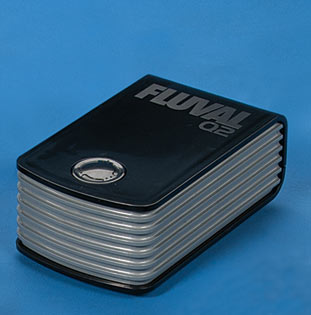Overview
| * | Powerful, advanced swing-arm and diaphragm air pumps create consistent, reliable air flow ideal for airstones, corner filters, under-gravel filters, and ornaments |
| * | Virtually silent air pumps feature double-walled construction, integrated pump well, noise-suppressing baffle chamber, and rubber feet |
| * | Q2 Air Pump also features adjustable air flow control for precise results |
Double-walled construction, an integrated pump well, a noise-suppressing baffle chamber, and rubber feet ensure virtually silent air pump operation. Sleek, powerful Fluval Q2 Air Pump is ideal for powering aquarium airstones, corner filters, under-gravel filters, and ornaments. Includes advanced swing-arm and diaphragm design for consistent, reliable air flow for your aquarium application. The Fluval Q2 Air Pump also features adjustable air flow control, maximizing airflow precision in your unique aquarium setup. Great for use in freshwater or saltwater aquariums. 6ft power cord.
| Model # | For aquariums |
Outlets | Watts | Pressure | Overall Dimensions |
| Q2 | 50-160 gallons | 1 | 4 | 3.4 | 7" x 4-1/4" x 3" high |
Installation
Install the air pump using one of these two recommended methods:
- Place the air pump on a surface lower than the water level of the aquarium. To avoid damage from accidentally spilled water, do not place the air pump directly below the aquarium. IMPORTANT: Always use a check valve (sold separately) in the airline between the air pump and the aquarium. The check valve will help prevent water from siphoning out of the aquarium through the air hose and into the pump in the event of a power failure, or when removing filters and other air-driven accessories from the aquarium.
- Place the air pump on a surface higher than the water level, such as a shelf. The surface should be at least 12 inches higher than the water level of the aquarium, but not be positioned directly above the aquarium. The surface should have a raised edge to prevent the air pump from sliding off. Use a check valve (sold separately) in the airline between the air pump and the aquarium to prevent backsiphoning.
Once the air pump is installed, do the following:
- Attach one end of the airline tubing (sold separately) to the air outlet(s) on the air pump.
- Attach the other end of the airline tubing to filters(s), air stone(s), ornament(s), or any other air-driven aquarium accessory. Ensure that the airline tubing has no restrictions or kinks.
- Plug air pump into outlet. Be sure to allow for a "drip loop."
- Place the pump in a location which is dry and relatively free from dust. Do not place the air pump on carpet, as fibers might collect on pump and prevent free-flowing air from entering pump. This will decrease the air output, cause overheating, and reduce the service life of the pump.
- Air control valves with multiple outlets may also be used to power additional apparatus in the aquarium. When using multiple air valves, you should have one more outlet than required by the accessories; this outlet will be used to bleed over-production of air due to back pressure buildup. Please refer to the Back Pressure section for more information about back pressure.
- Air pumps can be used to operate a variety of aquarium accessories such as air stones, corner filters, under-gravel filters, and ornaments. Follow installation instructions for your particular aquarium accessory product. Caution: Take care during installation to ensure that water cannot siphon out of the aquarium through the air hose and damage the air pump. To prevent back-siphoning when removing the filter, air stone, ornament, or any other air-driven aquarium accessory from the aquarium, do the following:
- Install a check valve.
- Leave the pump running while you disconnect tubing from the pump. Disconnect tubing and tape this end of the tubing to the very top frame of your aquarium.
- Filter(s), air stone(s), and other air-driven ornaments can now be safely removed from your aquarium.
Air Flow Adjustment (Q2 air pump only)
The Fluval Q2 air pump incorporates a flow-control knob (rheostat) to control air output. Turning the knob clockwise increases the air flow, counter-clockwise reduces the air flow. Proper air flow control reduces harmful back pressure and lengthens the service life of the pump. The Fluval Q1 air pump is not equipped with flow control; use an air control valve (sold separately) to regulate air output.
To achieve correct airflow, a balance between the valve setting and the pump output is necessary. The ideal setting is obtained by minimum back pressure or non-restriction of air flow. Never physically restrict the output of the pump. Restriction causes damage to the diaphragm (see Back Pressure section for more information). Adjust the air valve output as required.
To regulate air volume using an air control valve with multiple outlets, it is recommended to have the last valve available to release excess air pressure build up (see Back Pressure section for more information). In regulating the air pressure, it is best to work from the valve furthest from the input of the air valve. Remember to have the last valve completely closed so as not to lose any air pressure. Proceed to make adjustments on the remaining valves. Once the adjustments are complete, slowly open the last valve to the point where no loss of air output is noticed from the items controlled by the other valves. To achieve and maintain an equal balance of air pressure to the accessories in the aquarium, further adjustments of the air valve may be required depending on the items powered by the air pump. Note: If the first valve on the air control assembly is fully opened, air volume to the remaining outlets will be reduced.
To alleviate excess air pressure or overproduction of air, you should open the last valve every two weeks or when required. This will increase the life of the pump and diaphragms by preventing premature wear.
Back pressure
Back pressure is the buildup of pressure on the diaphragm due to restricted air flow. This occurs when excess air is produced by the air pump, or when the air channels are inadvertently blocked. Back pressure over time resulting from clogged air stones or other air system blockages and restrictions will cause the diaphragm to expand or rupture. An expanded diaphragm leads to a loss of air volume; a rupture results in the total loss of air.
External maintenance
Remove dust and dirt with a soft, damp cloth. Do not immerse pump in water. Do not use detergents.
Air stone, airline, and ornament maintenance
This pump requires no regular internal maintenance during its life. Periodically check and clean the rest of the air system.
- Carefully inspect airlines whenever performing standing aquarium maintenance. Adjust or replace (if required) all sections that are pinched, kinked, or otherwise damaged.
- Regularly maintain all attached air-driven aquarium ornaments. Remove algae growth from moving parts and keep them as clean as possible. Clean internal air tubes.
- Keep air stones clean and free of algae and debris. Ideally, replace them every month, alternating them with an extra set that has been cleaned and allowed to dry over that period. This will extend the life of the air stones, help keep back pressure to a minimum, maximize air pressure output, and extend the life of the air pump diaphragm.
Troubleshooting Tips
If the air pump fails to produce air, check the following:
- Ensure that the air pump is plugged in.
- Ensure that the air hose has no blockages and that all valves allow air passage. If no air is produced by the accessories in the aquarium, remove the airline from the pump and ensure that air is being produced.
- If the air pump produces no output, the most common problem encountered is a ripped or weakened diaphragm. Remove the airline. Unplug the air pump. Inspect the diaphragm for tears or rips. Any opening in the diaphragm will make it impossible for the pump to produce air for aeration purposes. Always inspect the diaphragm first before replacing other parts in the pump.
Removing the pump
Important: Whenever the air pump must be shut off and removed from the aeration system, always take off the air line before unplugging the pump. This will prevent water from siphoning back into the pump. If the airline cannot be removed before unplugging the power cord, raise the pump above the aquarium water level.
WARNING: This product can expose you to chemicals, including 1,3 Butadiene, which is known to the State of California to cause cancer and birth defects or other reproductive harm. For more information go to www.P65Warnings.ca.gov.






